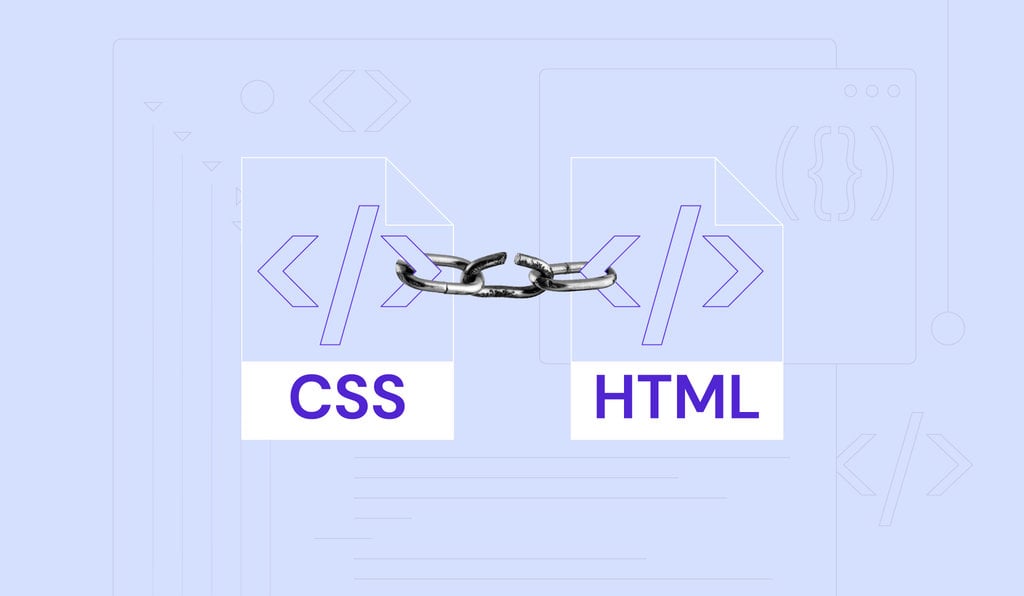How to Link CSS to HTML Files in Web Development

In web development, linking CSS to HTML files is a crucial step in defining the visual presentation of web pages. There are three ways to link CSS to HTML based on different types of CSS styles ‒ inline, internal, and external.
The external method involves linking an HTML document to an external CSS file, using the <link> tag placed in the <head> section of the HTML document.
Key attributes of this tag include rel=”stylesheet”, which defines the relationship between the HTML document and the linked CSS file, and type=”text/css”, specifying the stylesheet type.
The href attribute provides the path to the external CSS file, facilitating a streamlined approach to applying consistent styles across multiple web pages.
Keep reading as we’ll break down the steps and provide you with a comprehensive explanation of CSS and why you should use it.
Download complete CSS cheat sheet
How to Link CSS to HTML File – Video Tutorial
Looking for a visual guide? Check out this video.

How to Link CSS to HTML File Externally
While there are multiple approaches linking CSS to an HTML file, the most efficient way is to link an external style sheet to an HTML document. It requires a separate document with a .css extension, which solely contains all CSS rules without HTML tags.
Unlike internal and inline styles, this method changes many HTML pages by editing one CSS file. It saves time – there is no need to change each CSS property on every website’s HTML page.
Start linking style sheets to HTML files by creating an external CSS document using an HTML text editor and adding CSS rules. For instance, here are the style rules of example.css:
body {
background-color: yellow;
}
h1 {
color: blue;
margin-right: 30px;
}
Make sure not to add a space between the property values. For example, instead of margin-right: 30px, write margin-right: 30 px.
Then, use the <link> tag in the <head> section of your HTML page to link a CSS file to an HTML document. Next, specify the name of your external CSS file. In this case, it’s example.css so the code will look as follows:
<head> <link rel="stylesheet" type="text/css" href="example.css" media=”screen” /> </head>
For better understanding, here’s a breakdown of the attributes contained within the <link> tag:
- rel – defines the relationship between the linked document and the current one. Use the rel attribute only when the href attribute is present.
- type – determines the content of the linked file or document between the <style> and </style> tags. It has a text or css as the default value.
- href – specifies the location of the CSS file you want to link to the HTML. If both HTML and CSS files are in the same folder, enter only the file name. Otherwise, include the folder name in which you store the CSS file.
- media – describes the type of media the CSS styles are optimized for. In this example, we put screen as the attribute value to imply its use for computer screens. To apply the CSS rules to printed pages, set the value to print.
Once you’ve included the <link> element in your HTML file, save the changes and enter your website’s URL in your web browser. Styles written in the CSS file should change the look of the website.
Although external CSS helps make the web development process easier, keep in mind that HTML pages might not be rendered properly before the external style sheet is loaded. Furthermore, linking to several CSS documents can increase your website’s loading time.
On that note, if you want to edit a specific HTML element, it might be better to use the inline style method. Meanwhile, the internal or embedded style might be ideal for applying CSS rules to a single page.
Reasons to Use CSS
CSS is a style sheet language that manages the website’s visual representation. It consists of a list of formatting rules to style elements written in markup languages like HTML. In addition, CSS defines the display of HTML elements on various media types, such as projected presentations or television-type devices.
Whenever a browser finds a style sheet, it’ll convert the HTML file according to the provided style information. Hence, it’s important to link CSS to an HTML file to give your site a more engaging look across devices.
Other benefits from linking a CSS file to an HTML document are:
- Consistent design. Maintains formatting and design consistency throughout the website. A single adjustment on CSS rules can be applied universally to multiple areas of a website.
- Faster loading time. It only requires a single CSS file to style all HTML files. With fewer strings of code, a website can load faster. The site will also cache the CSS file for your visitors’ next visit.
- Improve SEO. Storing CSS styles in another file makes the HTML file more concise and organized. As a result, the website will have a cleaner and more lightweight code, which results in better crawlability by search engines.
On the other hand, CSS has several disadvantages, such as:
- Comes in multiple levels. The CSS style sheet has three levels. Such different frameworks can be confusing, especially for beginners.
- Compatibility issues. Some style sheets might not work on certain browsers as different browsers read CSS differently. Use CSS and HTML code validators to avoid these issues.
- Vulnerable to attacks. The open-source nature of CSS can increase the risk of cyberattacks. For example, a person with access to the CSS file might write malicious code or steal private data. However, proper security practices can prevent this issue.
All in all, CSS plays an important role when designing a website. It controls the formatting of various elements on a web page, such as fonts, background colors, and object positions. With the right application of CSS and HTML, a website can give an optimized user experience.
Conclusion
Embedding CSS rules to HTML elements can be time-consuming and energy-wasting. Luckily, external style sheets make the process more efficient.
CSS external style sheets are documents containing a list of style rules. Link them to an HTML document, and you’ll be able to change multiple pages at once, avoiding code bloat and keeping your HTML structure clean.
We hope that knowing how to set up your website by linking CSS to HTML easily will save you time to focus more on growing the traffic.
If you’re interested to learn more about coding, head to our guide on learning to code.

How to link CSS to HTML FAQ
How Do I Link HTML to CSS in HTML?
In order to link HTML to CSS in your HTML file, you need to use link tags with the right attributes. Remember that, as a self-closing tag, the link tag should be included in the head section of your HTML file.
Why Is My CSS Not Linking to HTML?
Check that your files are in the same folder if you have trouble linking your CSS to HTML. Check that the file path is correct if the CSS file is in a different folder.




Comments
September 21 2020
is there away to let the user switch to a new style sheet will in the webpage
November 18 2020
Hey there Andrew. You can just change the stylesheet that your website uses in the code.
September 30 2020
How to specify screen size ?
November 18 2020
Hey there Prakul. You can check this link here.
October 23 2020
brief and shoot smart tutor thank you
February 02 2021
Happy you enjoyed it!
December 19 2020
thanks alot with efficiency easy to connect now
February 09 2021
Happy you enjoyed it ;)
April 30 2021
brief and straight forward, i have enjoy it.
June 02 2021
I am taking a frontend course and today is the linking to CSS portion for me. I have come across a few methods of linking, but excelling is Merky M's. I like the data used and so, from now on when I used the linking method I learned here today, I will call it the Merky M method of stylesheet linking. This is the first time I have ever seen it spelled out. It is usually style or styles, I like that it is spelled out, it seems professional to me. So, it's the Merky M method of stylesheet linking for me, if they don't like they can lump it. Oh, and I've never seen the media element used anywhere and that's also professional. So, thanks Merky M great job showing a neophyte the right way to do things.
June 04 2021
Thank you homie i appreciate the help. You saved me some time with having the code already pieced together. I still read your article though. God bless you.
September 23 2021
You where great help, dude